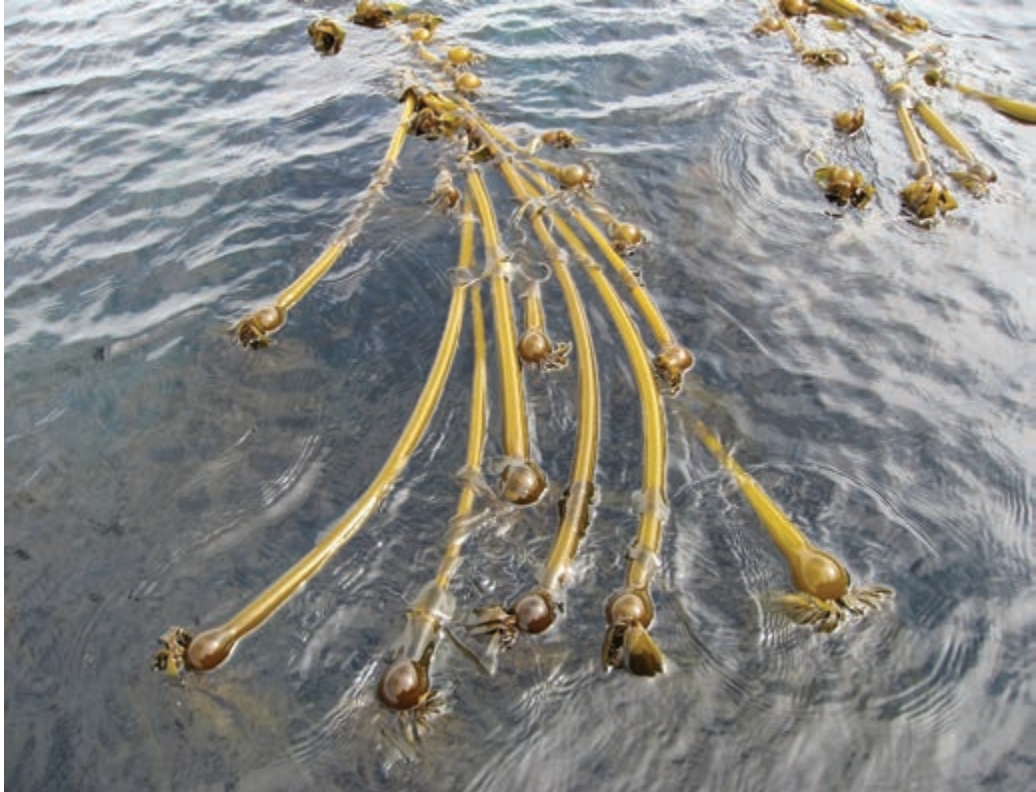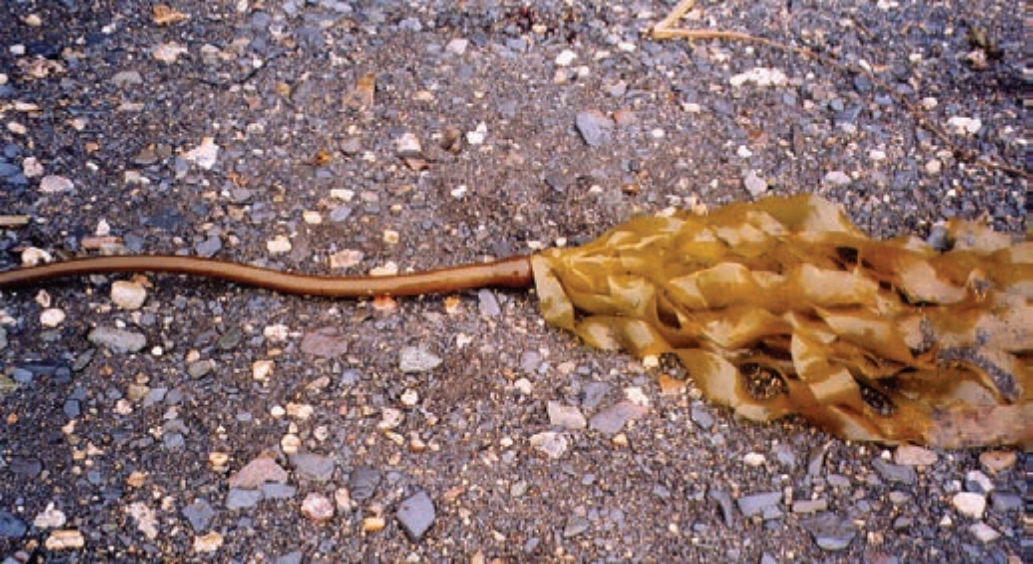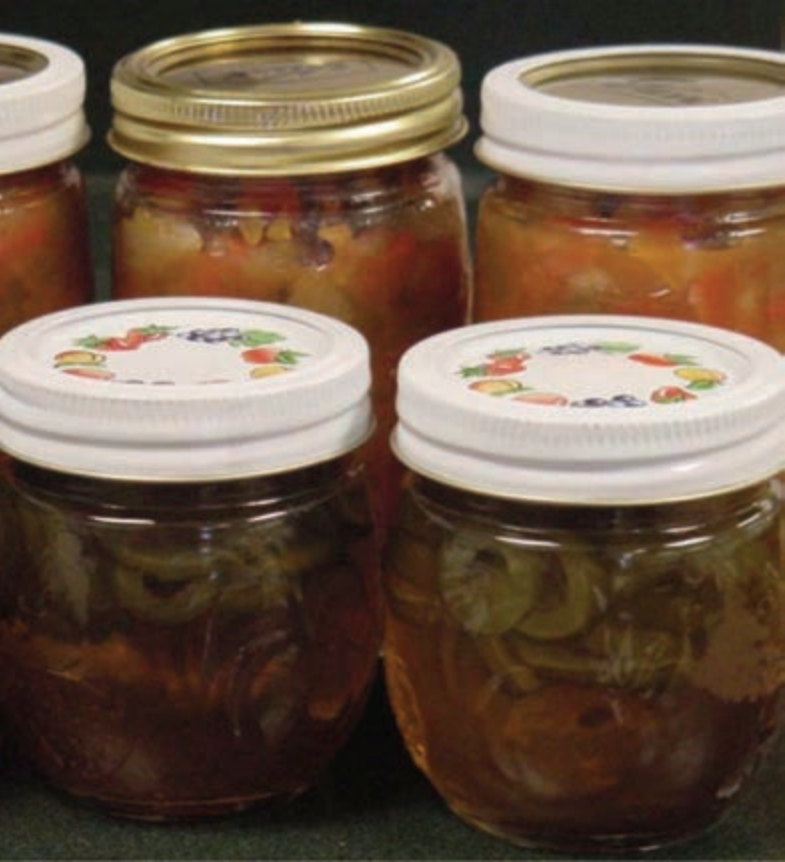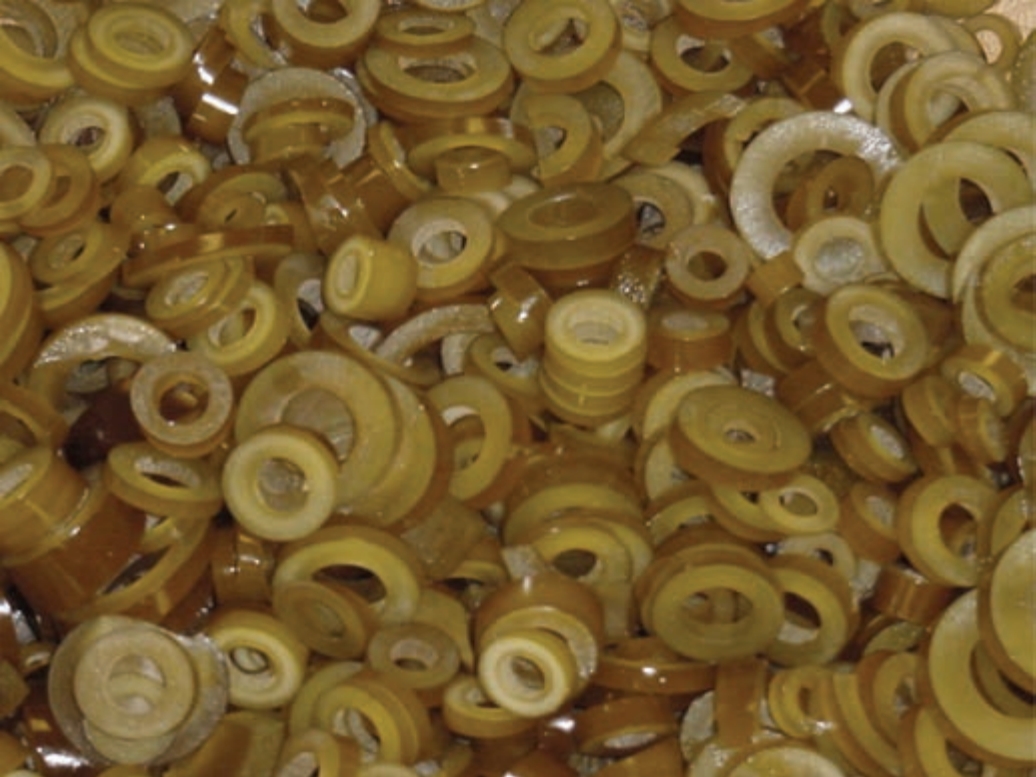Bullwhip Kelp
FNH-00131 View this publication in PDF form to print or download.
Bullwhip kelp (Nereocystis lutkeana), also called bull kelp, is a large seaweed belonging to the brown algae family. Growing in shallow bays or channels in depths of 30 feet or more, this impressive kelp can grow up to 100 feet in length. Bullwhip kelp is easily recognized by the long, hollow stem that terminates in a floating bulb on which long blades, 9 to 12 feet long, trail in the water. The stem, or stipe, is attached to the ocean bottom with a stout, rootlike holdfast. The bulb, the stipe and the blades are all edible.
Nutrition and Health

Seaweed harvesting is generally done in the spring and summer months, although some types of seaweed are available year-round. And, unlike many wild mushrooms, all common Alaska seaweeds are nontoxic. The greatest dangers to seaweed edibility are man-made. When seeking possible beaches for harvesting, assess the quality of the water. Look for any sewer or stormwater outfalls, old industrial sites, chemical spills or logging dumps in the immediate area that would contaminate the seaweed. You should also check with the Alaska Department of Environmental Conservation (DEC) for information about possible contaminated local water bodies. The DEC report, “Alaska’s Impaired Waters,” lists known contaminants by water body for many areas of Alaska. This report is available at the Integrated Water Quality Monitoring and Assessment Report page.
Research on the nutritional value of bullwhip kelp has been conducted, although not extensively. Preliminary research indicates that bullwhip kelp is low in fat, relatively high in protein and very high in potassium, sodium, iodine and magnesium. Bullwhip kelp is also a good source of dietary fiber.
Harvesting
Bullwhip kelp is best when harvested from June through August. Because it grows in subtidal areas, it may be reached only at low tides. Generally, at high tide all that can be seen is the top portion — the bulb and blades. Use a tide book to prepare for harvesting and familiarize yourself with the timing of the low tides. Generally, the early morning hours in spring coincide with low tides that make harvesting easier.
For collecting bullwhip kelp, a small boat or skiff is required. It’s unlikely you would be able to reach bullwhip kelp at low tide on foot. You’ll also need:
- A sharp knife.

- A bucket or a grocery bag, mesh bag or old pillowcase for holding the kelp. Do not use garbage bags since some are treated with chemicals and may contaminate your harvest.
- A large waterproof tote will protect your car from drips when transporting your harvest back home. In your boat, it will protect your harvest from potential contamination from boat gas and oil.
When you approach the kelp bed, sometimes referred to as a “cabbage patch,” carefully position the boat so that you can grasp the long stem, or stipe. Using the knife, cut down into the water as far as you can, but don’t fall in! If you don’t want the entire stipe, you may harvest only the bulb and/or blades from the top of the bulb.
Overharvesting of most sea vegetables is not yet a problem. However, be a considerate forager. Do not remove more than you need. Keep in mind that bullwhip kelp is one of the giant kelps that make up the great kelp forests, places that are home to many species, including sea otters, crabs, fish and other ocean creatures. Removing too much will result in the destruction of important habitat. The bulb of bullwhip kelp contains its reproductive organs, so harvesting bulbs before they release their spores may also lead to a reduction in the ecologically significant local kelp forests.
Selection, Cleaning and Storage
Occasionally, fresh bullwhip kelp may be found washed up along the shore after a storm. You may harvest and use this kelp if it is still olive brown in color and appears moist. Do not use beached bullwhip kelp if it shows signs of aging such as a woody texture on the exterior, a white interior that displays “cottonlike” fibers and a strong taste of salt. While bullwhip kelp does have a high salt content, the fresh stipe should not have an overwhelming saltiness.
The bullwhip kelp stipe and the blades are handled and prepared differently. However, the bulb and the stipe may be processed together in recipes. It’s best to process the stipe and bulb within 24 hours of harvest as bullwhip kelp does not keep well under refrigeration or by freezing.
Blades
Use fresh, rinsed blades in salads, stir-fries or soups. Use your imagination and creativity and add blades to your favorite dishes. To preserve for storage, the blades will need to be dried.
To dry bullwhip kelp
- Rinse in fresh water.
- Hang to dry outside.
- If it is raining, dry blades indoors; however, your house will smell of the sea.
- Dry in a dehydrator or in the oven at 140 degrees F.
When the blades are dry they will be darker brown in color and shriveled up. Store in airtight containers in a cool, dry place.
Stipes (and bulbs)
The stipe and bulb can be used fresh. However, the most common preservation method used for the stipe is pickling. To prepare the stipe for processing:
- Rinse in freshwater to remove the excess salt.
- Peel away the brownish outer layer using a vegetable peeler or sharp knife. The outer brown skin will become slimy when it’s out of the saltwater. Hold with a paper towel to keep a grasp on the stipe.
- The inner “flesh” of the kelp should be a light green in color and firm to the touch.
Cut the peeled stipe into rings or slices. When using slices, they should fit into the jars you are using.
Kelp pickles are preserved using the boiling water canning method. Keep clean jars hot until ready to use. For detailed steps on boiling water canning, refer to the Extension publication FNH-00705, Canning Overview or “Boiling Water Canning Basics” video on YouTube: Boiling Water Canner Basics. Written publications are available for free download on the CES website: UAF/CES Publications.
Recipes
Bullwhip Kelp Dill Pickles
- 4–6 pounds bullwhip kelp cut into rings or strips
- 3 cups white vinegar (5 percent)
- 3 cups water
- 6 tablespoons canning and pickling salt
- ¼–⅓ cup fresh or dried dill (divided)
- ¼–⅓ cup mustard seed (divided)
- 4 cloves fresh garlic, chopped, or ¼–⅓ cup dried garlic (divided)
Begin the pickling process by preparing the brine. In a large pot mix the vinegar, water and salt. Bring to a boil and keep hot.
To pack the jars
In the bottom of each hot pint jar, sprinkle 1–2 teaspoons of the dill, garlic and mustard seed. The amount used depends on how spicy you like your pickles.
Pack the kelp slices or rings into the hot jars.
When the jars are half filled with the kelp, add more dill, then finish filling the jar with kelp. Fill the jars tightly, leaving a ½-inch headspace.
Pour hot brine over the kelp, leaving a ½-inch headspace. Remove air bubbles by sliding a rubber spatula or plastic knife down the sides of the jar, pushing the contents slightly to allow air bubbles to float to the top and settling the ingredients.
Wipe the top rim of the jar with a clean cloth or paper towel. Place the lid and ring on the jar.
Process the pickles in the boiling water canner for 11 minutes for one pint or smaller jar.
Yield: 6 pints
Bullwhip Kelp Sweet Pickles
- 6–8 pounds bullwhip kelp cut into ½-inch chunks
- 3½ cups white vinegar (5 percent)
- 4½ cups white sugar
- 2 teaspoons celery seed
- 1 tablespoon whole allspice
- 2 tablespoons mustard seed

Begin the pickling process by preparing the brine. Combine all ingredients together in the large pot, except for kelp. Bring mixture to a boil. Keep hot.
Pack the kelp chunks into the hot pint jars. Leave a ½-inch headspace. Pour hot brine over the kelp, keeping the ½-inch space at the top of the jar.
Remove air bubbles by sliding a rubber spatula or plastic knife down the sides of the jar, pushing the contents slightly to allow air bubbles to float to the top and settling the ingredients.
Wipe the top rims of the filled jars with a clean cloth or paper towel. Place prepared lids and rings on the jars.
Process one pint or smaller jars of pickles in the boiling water canner for 16 minutes.
Yield: 4 pints
NOTE: Most seaweeds can be harvested for personal use. However, some restrictions may apply. For more information, contact your local Cooperative Extension office, the Sea Grant Marine Advisory Program or the Alaska Department of Fish and Game.
Sarah R-P. Lewis, Extension Faculty, Health, Home and Family Development. Originally written by Roxie Rodgers Dinstel and Sonja Koukel, former Extension Faculty, Health, Home and Family Development.
Revised March 2022

